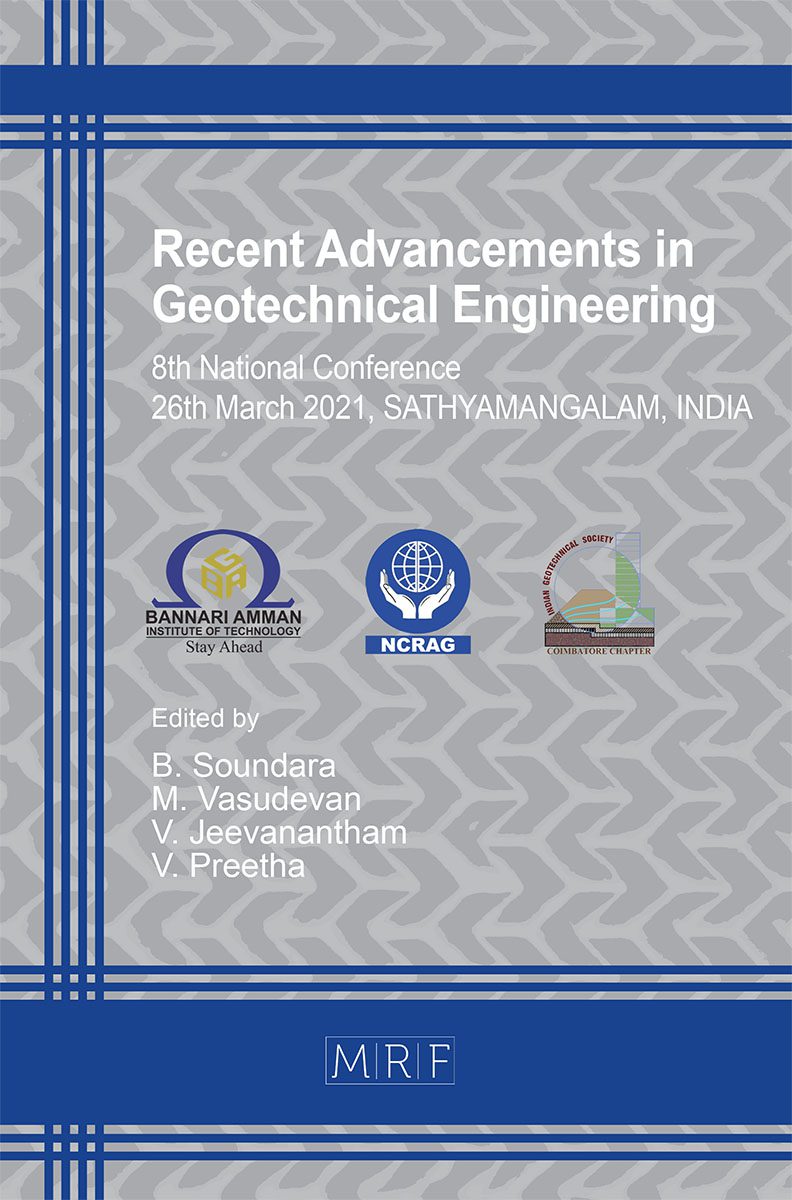Investigation on Retrofitting of Reinforced Concrete Beam with Glass Fiber and Banana Fiber Mat
M. Rajendran, S. Sanjaygandhi, V. Senthilkumar, S. Ramakrishnan
download PDFAbstract. Concrete is the predominant material in the construction industry. To be sustainable, the old Reinforced Concrete (RC) buildings should be retrofitted, and the life of the building should be extended. Experimental study has been attempted to investigate the load carrying capacity of concrete beam strengthened with glass fiber and banana fiber mat. The primary aim of this study is to retrofit the RC beam specimen to enhance the load carrying capacity. All the beams were casted with the same grade of concrete (M30) and same structural detailing. Two-point symmetrical loading were given to the control beams to obtain load at initial crack and ultimate load. Then the beams other than control beams were loaded till it showes initial crack and then retrofitted with banana fiber and glass fiber bonded externally with resin. The retrofitted beams were tested for ultimate load performance. Load carrying capacity was higher for both retrofitting but the beam retrofitter with glass fiber showed significant improvement in the ultimate load carrying capacity.
Keywords
Retrofitting, Reinforced Concrete Beam, Glass Fiber, Banana Fiber, Ultimate Load Carrying Capacity
Published online 8/15/2021, 11 pages
Copyright © 2021 by the author(s)
Published under license by Materials Research Forum LLC., Millersville PA, USA
Citation: M. Rajendran, S. Sanjaygandhi, V. Senthilkumar, S. Ramakrishnan, Investigation on Retrofitting of Reinforced Concrete Beam with Glass Fiber and Banana Fiber Mat, Materials Research Proceedings, Vol. 19, pp 150-160, 2021
DOI: https://doi.org/10.21741/9781644901618-19
The article was published as article 19 of the book Recent Advancements in Geotechnical Engineering
![]() Content from this work may be used under the terms of the Creative Commons Attribution 3.0 licence. Any further distribution of this work must maintain attribution to the author(s) and the title of the work, journal citation and DOI.
Content from this work may be used under the terms of the Creative Commons Attribution 3.0 licence. Any further distribution of this work must maintain attribution to the author(s) and the title of the work, journal citation and DOI.
References
[1] Sandeep G. Sawant, A. B. Sawant, M. B. Kumthekar, Strengthening of R.C.C. Beam-Using Different Glass Fiber, International Journal of Inventive Engineering and Sciences (IJIES) Volume 1, Issue 2(2013).
[2] T.Sirisha, A.V.S Sai kumar , B.Madhanna, Use of Discrete Fiber in Construction, International Journal of Innovative Research in Science, Engineering and Technology,Volume 5, Issue 8 (2016),pp. 15249-15253.
[3] Mohanraj A, Rajendran M, Ramesh A S, Mahalakshmi M, Manoj Prabhakar S, An Experimental Investigation of Eco-Friendly Self-Curing Concrete Incorporated with Polyethylene Glycol, International Advanced Research Journal in Science, Engineering andTechnology,Volume 1, Issue 2 (2014), pp. 85-89.
[4] Rahul Dev Bharti, Prof. Nitesh Khuswaha, Comparative Study on RCC Beams with & without Carbon Fiber Reinforced Polymer Using Ansys Software, International Journal of Trend in Scientific Research and Development (IJTSRD),Volume 4, Issue 1(2019), pp.478-482.
[5] P. Arulsivanantham, Experimental Study on usage of Class-E Glass Fiber in the Cement Concrete, International Journal of Engineering Research & Technology (IJERT), Volume 4, Issue 6 (2015), pp. 116-121. https://doi.org/10.17577/IJERTV4IS060183
[6] K.M. Mini, Rini John Alapatt, Anjana Elizabeth David, Aswathy Radhakrishnan, Minu Maria Cyriac and R. Ramakrishnan, Experimental study on strengthening of R.C beam using glass fiber reinforced composite, Structural Engineering and Mechanics, Volume 50, Number 3 (2014), pp.275-286. https://doi.org/10.12989/sem.2014.50.3.275
[7] T.P. Meikandaan, Dr. A. Ramachandra murthy, Retrofitting of reinforced concrete beams using GFRP overlays, International Journal of Civil Engineering and Technology (IJCIET), Volume 8, Issue 2 (2017), pp.423-439.
[8] Saman Khan, Roohul Abad Khan, Amadur Rahman Khan, Misbahul Islam, Saman Nayal, Mechanical properties of polypropylene fiber reinforced concrete for M25 & M30m mixes: a comparative study, International Journal of ScientificEngineering and Applied Science (IJSEAS), Volume 1, Issue 6 (2015).
[9] D.N. Shinde, Pudale Yojana M, Nair Veena V, Flexural Behaviour of Reinforced Cement Concrete Beam Wrapped with GFRP sheet, International Journal of Research in Engineering and Technology, Volume 3, Issue 30 (2014), pp.760-763. https://doi.org/10.15623/ijret.2014.0315143
[10] K.Srinivasa Rao, S.Rakesh kumar, A.Laxmi Narayana, Comparison of Performanceof Standard Concrete and Fiber Reinforced Standard Concrete Exposed to Elevated Temperatures, American Journal of Engineering Research (AJER), Volume 2, Issue 3 (2010), pp 20-26.
[11] Kavita S Kene, Vikrant S Vairagade and Satish Sathawane, Experimental Study on Behavior of Steel and Glass Fiber Reinforced Concrete Composites,Bonfring International Journal of Industrial Engineering and Management Science Volume 2, Number 4 (2012), pp. 125-130. https://doi.org/10.9756/BIJIEMS.1617
[12] T.P. Meikandaan, Dr. A. Ramachandra murthy, Retrofitting of Reinforced Concrete Beams using GFRP Overlays, International Journal of Civil Engineering and Technology (IJCIET),Volume 8, Issue 2 (2017), pp.423-439.
[13] Nanditha Mandava, Kallempudi Murali, M. Srinadh Reddy, M Narendranatha Reddy, Investigation of Reinforced Concrete Beams by Incorporating Polypropylene Fiber Reinforced Polymer Composites, International Journal of Civil Engineering and Technology (IJCIET),Volume 9, Issue 1, (2018), pp. 423-430.
[14] IS: 516-1959 (2006),Indian Standard Methods of Tests for Strength of Concrete, Bureau of Indian Standards, New Delhi, India.
[15] S. Shankarananth, B. Jaivignesh, Experimental Study on the use of Glass Powder, GGBS & Perlite in Flyash Bricks,International Journal of AdvancedResearch,Volume 4 (2016), pp 1381-1387. https://doi.org/10.21474/IJAR01/292
[16] IS:10262 (2009),Concrete Mix Proportioning-Guidelines, Bureau of Indian Standards, New Delhi, India.































